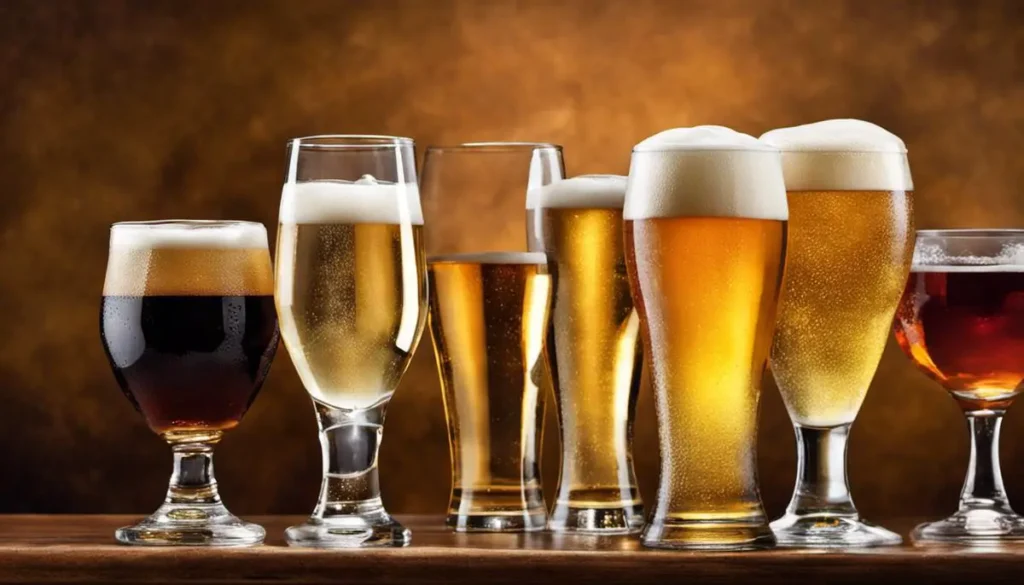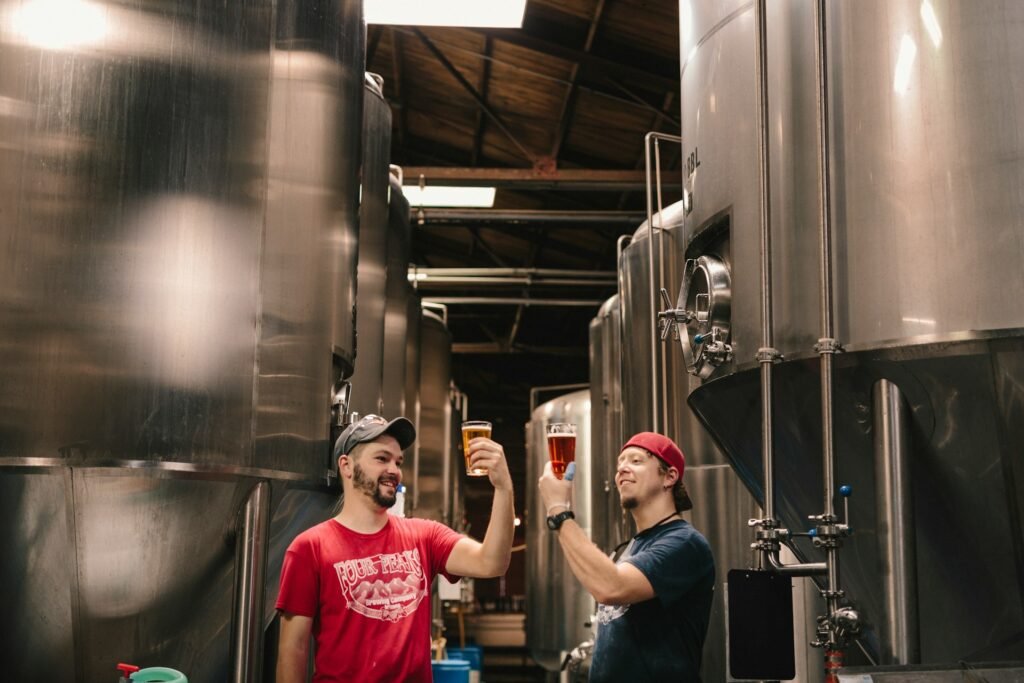Understanding the alcohol content in beer is essential for young men in the middle class, especially those who value their health and social interactions. The “alcohol content of a beer” is a crucial factor when choosing beverages, as it directly impacts the body and overall experience. By being aware of the alcohol content, individuals can make informed decisions about their consumption levels and potential health implications.
The percentage of alcohol in a beer, often measured as ABV (Alcohol by Volume), plays a significant role in how it affects the body. For young adults aged 18-35, knowing the “alcohol content in a can of beer” is crucial for managing their alcohol intake during social gatherings or casual settings. This knowledge empowers them to enjoy beer responsibly, balancing social enjoyment and health considerations.
By grasping the importance of alcohol content in beer, young men can navigate social situations confidently, prioritize their well-being, and make educated choices about their beverage selections. This article will delve deeper into the factors influencing alcohol content in beer, helping readers understand the nuances of this critical aspect of their drinking choices.
Table of Contents
What is Alcohol Content?

The alcohol content in beverages, often measured as ABV (Alcohol by Volume), is a crucial factor to consider when enjoying a beer. Understanding the “alcohol content of a beer” is essential for young adults who are mindful of their health and social interactions.
ABV indicates the percentage of alcohol in a beverage, influencing its effects on the body and overall experience. For young middle-class men, being aware of the alcohol content in the beer they consume can help them make informed choices about their consumption levels and potential health impacts.
Knowing the “alcohol content in a can of beer” can also guide individuals in managing their alcohol intake during social gatherings or casual settings. This knowledge empowers young adults to enjoy beer responsibly, balancing their social lives with health considerations.
By grasping the significance of beer’s alcohol content, young men can navigate social situations with confidence, prioritize their well-being, and make informed decisions about their beverage choices.
Factors Influencing Alcohol Content in Beer
Understanding the factors that influence the alcohol content in beer is essential for middle-class young men who are conscious of their health and social choices. Different types of beer have varying alcohol content ranges, with factors such as the brewing process and ingredients playing crucial roles.
When it comes to beer types, lighter varieties like lagers typically have lower alcohol content compared to heavier options such as stouts or IPAs. The brewing process also affects alcohol content, with longer fermentation often resulting in higher alcohol percentages. Additionally, ingredients like yeast and grains contribute to determining the final alcohol content of a beer.
By being aware of these factors, young men can make informed decisions about the beers they consume, aligning their preferences with their health goals and social interactions. Understanding how these elements influence alcohol content empowers individuals to enjoy beer responsibly while appreciating the craftsmanship and complexity behind their favorite brews.
How to Determine the Alcohol Content of a Beer

Understanding how to determine the alcohol content of the beer you are drinking is crucial for young men in the middle class who value making informed choices about their health and social interactions. One way to do this is by reading beer labels and paying attention to the ABV (alcohol by volume) percentages. This information is typically displayed on the packaging and clearly indicates how much alcohol is in the beer.
Utilizing online resources and databases can benefit those looking for more detailed information. These platforms provide comprehensive data on beer brands and their alcohol content, allowing you to compare different options and make educated decisions based on your preferences and health goals.
Moreover, mobile apps and tools are specifically designed to help track the alcohol content in beer. These apps can provide real-time information, suggest lower-alcohol alternatives, and even offer personalized recommendations based on your taste preferences. By leveraging these resources, young men can confidently navigate the diverse world of beers, ensuring they enjoy their favorite brews responsibly while staying mindful of their alcohol intake.
Alcohol Content in Different Beer Varieties

When exploring the world of beer, it’s essential for young men in the middle class to understand the alcohol content in different beer varieties. Common beer types such as lagers, ales, stouts, and IPAs each have their own typical alcohol content ranges. For instance, lagers generally have a lower alcohol content compared to ales, which can vary widely. Stouts often have a higher alcohol content, providing a richer and more robust flavor profile. IPAs, known for their hoppy bitterness, typically fall in the middle range of alcohol content.
Craft beers, popular among young adults seeking unique flavors and quality ingredients, often boast higher alcohol content than commercial beers. This difference stems from the craft brewing process, which allows for more creativity and experimentation with alcohol levels. On the other hand, commercial beers tend to have more standardized alcohol content to cater to a broader audience.
Beer Varieties, Flavor and ABV (Alcohol by Volume)
Here’s a table listing various types of beer, their flavor characteristics, and their typical ABV ranges:
| Beer Type | Flavor Characteristics | ABV Range |
|---|---|---|
| Lager | Light, crisp, clean, often with mild hop bitterness. | 4.0% – 5.0% |
| Pilsner | Crisp, refreshing, slightly bitter, with a light malt flavor and floral or spicy hop notes. | 4.2% – 5.5% |
| Pale Ale | Balanced, with a moderate hop bitterness and malt sweetness, often with fruity or floral aromas. | 4.5% – 6.2% |
| India Pale Ale (IPA) | Strong hop bitterness, often with citrus, pine, or floral flavors, balanced by malt sweetness. | 5.5% – 7.5% |
| Double IPA | Intense hop bitterness, strong malt backbone, often with high alcohol warmth and complex flavors. | 7.5% – 10.0% |
| Stout | Dark, rich, with roasted malt flavors, often including coffee, chocolate, and caramel notes. | 4.0% – 7.0% |
| Porter | Dark, similar to stout but generally lighter in body, with chocolate and caramel malt flavors. | 4.5% – 6.5% |
| Brown Ale | Nutty, caramel, and toasty malt flavors, often with a slight sweetness and low hop bitterness. | 4.2% – 6.0% |
| Wheat Beer | Light, refreshing, with a smooth mouthfeel and often with fruity or spicy yeast characteristics. | 4.0% – 5.5% |
| Belgian Ale | Complex, with fruity, spicy, and sometimes earthy yeast flavors, often with a dry finish. | 6.0% – 9.0% |
| Saison | Dry, crisp, with fruity, spicy, and sometimes tart flavors, often with a peppery finish. | 5.0% – 8.0% |
| Sour Beer | Tart, acidic, with a wide range of fruity, funky, and sometimes earthy flavors from wild fermentation. | 3.0% – 7.0% |
| Barleywine | Strong, malty, with rich caramel, toffee, and sometimes dark fruit flavors, often with high alcohol warmth. | 8.0% – 12.0% |
| Bock | Malty, with rich caramel and toasty flavors, often with a smooth, slightly sweet finish. | 6.0% – 7.5% |
| Dunkel | Dark lager with smooth malt flavors, including chocolate, caramel, and nutty notes. | 4.5% – 5.6% |
| Hefeweizen | Wheat beer with banana and clove yeast flavors, often with a smooth, creamy mouthfeel. | 4.9% – 5.5% |
| Kolsch | Light, crisp, with a delicate balance of malt sweetness and hop bitterness, often with fruity notes. | 4.4% – 5.2% |
This table provides a broad overview of the diverse world of beer, highlighting the wide range of flavor profiles and alcohol content available across different styles.
Moreover, seasonal and specialty beers offer exciting variations in alcohol content. Seasonal brews like winter ales or pumpkin beers may have higher alcohol content to complement their bold flavors, while specialty beers like barrel-aged or sour ales can surprise with unique alcohol content profiles. Understanding these differences empowers young men to choose beers that align with their preferences and occasions, ensuring a well-rounded drinking experience.
Alcohol Levels In Top Beer Brands
Here’s a table listing some top beer brands, their types, flavor characteristics, and ABV:
| Beer Brand | Type | Flavor Characteristics | ABV |
|---|---|---|---|
| Budweiser | Lager | Light, crisp, slightly malty, with mild hop bitterness. | 5.0% |
| Heineken | Lager | Crisp, clean, with a slightly bitter finish and mild hop flavor. | 5.0% |
| Corona Extra | Pale Lager | Light, crisp, with a mild malt sweetness and a hint of citrus. | 4.6% |
| Guinness | Stout | Rich, creamy, with roasted malt flavors, including coffee and chocolate notes. | 4.2% |
| Samuel Adams Boston Lager | Lager | Balanced, with a rich malty sweetness and subtle hop bitterness, caramel and toffee notes. | 5.0% |
| Sierra Nevada Pale Ale | Pale Ale | Hoppy, with citrus and pine flavors, balanced by a malt backbone. | 5.6% |
| Blue Moon Belgian White | Wheat Beer | Smooth, with a slightly sweet, citrusy flavor, often served with an orange slice. | 5.4% |
| Stella Artois | Lager | Crisp, with a slightly sweet malt flavor and mild hop bitterness. | 5.0% |
| Dogfish Head 90 Minute IPA | Double IPA | Strong hop bitterness, with malt sweetness, caramel, and a high alcohol warmth. | 9.0% |
| Founders All Day IPA | Session IPA | Hoppy, with citrus and pine flavors, lower in alcohol for easy drinking. | 4.7% |
| Hoegaarden | Witbier | Light, refreshing, with coriander and orange peel notes, slightly tart. | 4.9% |
| Pilsner Urquell | Pilsner | Crisp, with a slightly bitter finish, floral hop aroma, and a light malt flavor. | 4.4% |
| New Belgium Fat Tire | Amber Ale | Malty, with caramel and toasty flavors, balanced by a mild hop bitterness. | 5.2% |
| Chimay Blue | Belgian Strong Ale | Complex, with dark fruit, caramel, and spice flavors, high alcohol warmth. | 9.0% |
| Bass Pale Ale | Pale Ale | Malty, with a slight sweetness, balanced by earthy hop bitterness. | 5.1% |
| Leffe Blonde | Belgian Ale | Smooth, with fruity and spicy yeast flavors, slightly sweet. | 6.6% |
| Lagunitas IPA | IPA | Strong hop bitterness, with citrus and pine flavors, balanced by a malt backbone. | 6.2% |
| Anchor Steam | California Common | Malty, with caramel and toasty flavors, balanced by a subtle hop bitterness. | 4.9% |
| Weihenstephaner Hefeweissbier | Hefeweizen | Banana and clove yeast flavors, smooth and creamy mouthfeel. | 5.4% |
| Doppelbock | Paulaner Salvator | Rich, malty, with caramel and toffee flavors, smooth and slightly sweet. | 7.9% |
This table highlights a selection of well-known beer brands, showcasing the variety of flavors and ABV ranges available in popular beer styles.
Health Implications of Alcohol Content in Beer

High-alcohol-content beers can have significant health implications for young men in the middle class. When indulging in these beverages, it’s crucial to be aware of both the short-term effects and long-term risks they pose. Short-term effects may include impaired judgment, coordination, and memory, leading to risky behaviors. Additionally, consuming high-alcohol beers can result in dehydration, hangovers, and even alcohol poisoning if consumed excessively.
Regular consumption of high-alcohol-content beers can lead to long-term health risks such as liver damage, heart problems, and an increased risk of developing alcohol use disorder. It’s essential for young men to understand the importance of moderation and to recognize their personal limits when it comes to alcohol consumption. By being mindful of how much they drink and choosing beers with moderate alcohol content, individuals can enjoy the social aspects of drinking while prioritizing their health and well-being.
Social and Lifestyle Considerations

When it comes to social drinking situations, understanding the alcohol content of the beer you are consuming is crucial. Young men in the middle class often find themselves in various social settings where alcohol plays a significant role. Whether it’s a casual gathering with friends, a celebratory event, or a professional networking opportunity, choosing beers with appropriate alcohol content is key. Opting for lower alcohol varieties can help individuals maintain control over their consumption and avoid the negative consequences associated with excessive drinking.
Balancing enjoyment and responsibility is essential when it comes to beer consumption. By being mindful of the alcohol content in the beers they choose, young men can ensure they are making responsible decisions while still enjoying the social aspects of drinking. Understanding how different alcohol levels can impact their experience allows individuals to tailor their choices based on the occasion and their personal preferences. This approach not only promotes safer drinking habits but also enhances the overall social experience by fostering a sense of moderation and control.
Final Thoughts About Alcohol Content of A Beer
Understanding the alcohol content of the beer you are drinking is crucial for young men in the middle class, especially in social settings. By choosing beers with appropriate alcohol levels, individuals can enjoy social gatherings responsibly. Opting for lower alcohol varieties promotes moderation and helps prevent excessive drinking, ensuring a safer and more enjoyable experience.
When it comes to beer consumption, balancing enjoyment with responsibility is key. Being aware of how different alcohol levels can impact one’s experience allows for tailored choices based on personal preferences and the occasion at hand. This mindful approach not only fosters a sense of control but also enhances the overall social experience.
By making informed decisions about the alcohol content in the beers they consume, young men can prioritize their health and well-being while still participating in social events. This knowledge empowers individuals to navigate social drinking situations with confidence, promoting a culture of responsible alcohol consumption within their social circles.
Additional Resources
For young men in the middle class interested in delving deeper into the world of beer and alcohol content, there are valuable resources available to enhance their knowledge and promote responsible consumption.
To further explore the intricacies of alcohol content in beer, consider visiting reputable sources such as the Brewers Association or BeerAdvocate. These platforms offer detailed insights into different beer varieties, brewing processes, and how alcohol content is measured, providing a comprehensive understanding of the topic.
For those looking to track and manage their alcohol intake effectively, utilizing apps like “DrinkControl” or tools like the “BACtrack Mobile Breathalyzer” can be beneficial. These resources help individuals monitor their consumption levels, set limits, and make informed decisions about their drinking habits.
In case you have any concerns about alcohol consumption or seek professional guidance, don’t hesitate to reach out to health professionals or support groups specializing in alcohol-related issues. They can provide personalized advice, resources, and assistance tailored to your specific needs and circumstances. Remember, prioritizing your health and well-being is essential, and seeking help when needed is a sign of strength and self-care.




